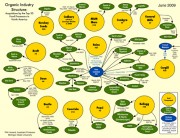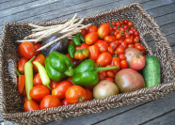According to the U.S. Department of Agriculture’s most recent statistics, the average age of farmers in the United States is 57. In 1982, 16 percent of head farmers were younger than 35, but by 2007 that number had declined to 5 percent. But behind the aging industry an even larger force is at work: the consolidation of U.S. farmland, experts say.
In order to remain competitive, farmers had to grow larger amounts of commodity crops over the past century to make up for the decreasing value of food. This subsidized part of the food system has decreased the number of farmers as farmland has been consolidated to grow more commodities. The difficulty in achieving an income consistent and large enough to support families has also made farming a less appealing career to many of the next generation growing up under the current farmers.
However, not all hope is lost. A growing national trend of learning where our food comes from is rejuvenating the local food system – on a national scale. There are a growing number of younger farmers (and former professionals interested in turning farmer) who are creatively breaking down barriers to entry in small-scale agriculture. The biggest barrier to start farming is land cost versus the expected value a young farmer can expect to get out of a farming operation. Land has simply become too expensive if it can actually produce something useful for us. But, this new wave of farmers is taking a lean approach to growing, which makes it more affordable. It actually costs very little to grow vegetables in small-scale and there are lots of creative ways to make small pieces of land produce quite a bit of food. Bowing out of the commodity rat-race helps new and young farmers find niche markets for less expensive foods.
We have seen and learned so much from our local farmers here in the Charlotte area. The creativity they have to circumvent problems in farming is amazing and inspiring. We are lucky to be in an area with such potential for a healthy, sustainable food system.












RSS
Facebook
Twitter
Google +1
LinkedIn
Youtube
Pinterest